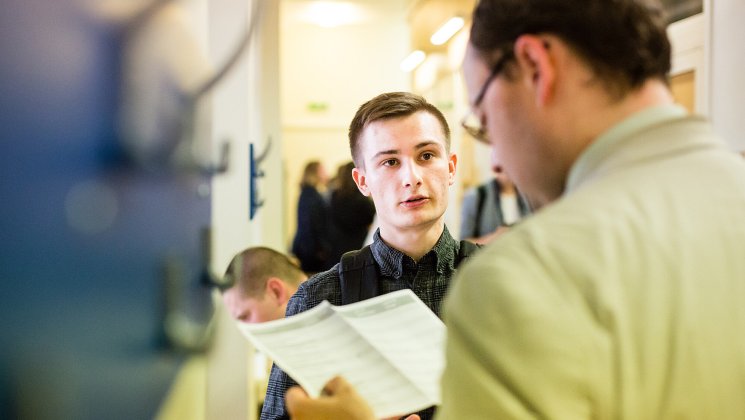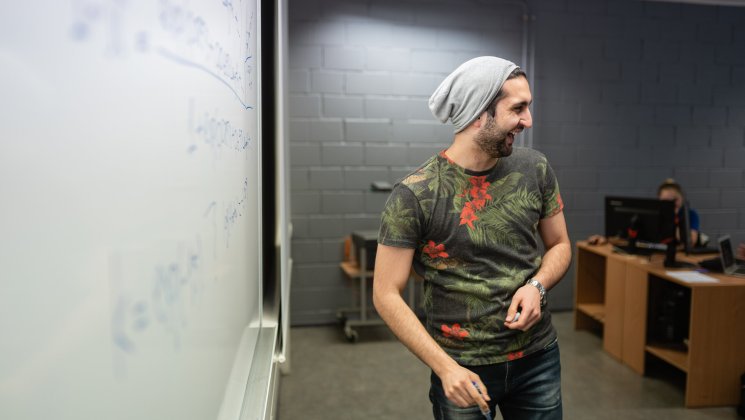-
Faculty of Arts and HumanitiesDean's Office, Faculty of Arts and HumanitiesJakobi 2 ruumid 116–121, 51005 Tartu linn, EST0Institute of History and ArchaeologyJakobi 2 51005 Tartu linn, Tartu linn, Tartumaa EST0Institute of Estonian and General LinguisticsJakobi 2, IV korrus 51005 Tartu linn, Tartu linn, Tartumaa EST0Institute of Philosophy and SemioticsJakobi 2, III korrus, ruumid 302-337 51005 Tartu linn, Tartu linn, Tartumaa EST0Institute of Cultural ResearchÜlikooli 16 51003 Tartu linn, Tartu linn, Tartumaa EST0Institute of Foreign Languages and CulturesLossi 3 51003 Tartu linn, Tartu linn, Tartumaa EST0School of Theology and Religious StudiesÜlikooli 18 50090 Tartu linn, Tartu linn, Tartumaa EST0Viljandi Culture AcademyPosti 1 71004 Viljandi linn, Viljandimaa EST0Professors emeriti, Faculty of Arts and Humanities0Associate Professors emeriti, Faculty of Arts and Humanities0Faculty of Social SciencesDean's Office, Faculty of Social SciencesLossi 36 51003 Tartu linn, Tartu linn, Tartumaa EST0Institute of EducationJakobi 5 51005 Tartu linn, Tartu linn, Tartumaa EST0Johan Skytte Institute of Political StudiesLossi 36, ruum 301 51003 Tartu linn, Tartu linn, Tartumaa EST0School of Economics and Business AdministrationNarva mnt 18 51009 Tartu linn, Tartu linn, Tartumaa EST0Institute of PsychologyNäituse 2 50409 Tartu linn, Tartu linn, Tartumaa EST0School of LawNäituse 20 - 324 50409 Tartu linn, Tartu linn, Tartumaa EST0Institute of Social StudiesLossi 36 51003 Tartu linn, Tartu linn, Tartumaa EST0Narva CollegeRaekoja plats 2 20307 Narva linn, Ida-Virumaa EST0Pärnu CollegeRingi 35 80012 Pärnu linn, Pärnu linn, Pärnumaa EST0Professors emeriti, Faculty of Social Sciences0Associate Professors emeriti, Faculty of Social Sciences0Faculty of MedicineDean's Office, Faculty of MedicineRavila 19 50411 Tartu linn, Tartu linn, Tartumaa ESTInstitute of Biomedicine and Translational MedicineBiomeedikum, Ravila 19 50411 Tartu linn, Tartu linn, Tartumaa ESTInstitute of PharmacyNooruse 1 50411 Tartu linn, Tartu linn, Tartumaa ESTInstitute of DentistryL. Puusepa 1a 50406 Tartu linn, Tartu linn, Tartumaa ESTInstitute of Clinical MedicineL. Puusepa 8 50406 Tartu linn, Tartu linn, Tartumaa ESTInstitute of Family Medicine and Public HealthRavila 19 50411 Tartu linn, Tartu linn, Tartumaa ESTInstitute of Sport Sciences and PhysiotherapyUjula 4 51008 Tartu linn, Tartu linn, Tartumaa ESTProfessors emeriti, Faculty of Medicine0Associate Professors emeriti, Faculty of Medicine0Faculty of Science and TechnologyDean's Office, Faculty of Science and TechnologyVanemuise 46 - 208 51003 Tartu linn, Tartu linn, Tartumaa ESTInstitute of Computer ScienceNarva mnt 18 51009 Tartu linn, Tartu linn, Tartumaa ESTInstitute of GenomicsRiia 23b/2 51010 Tartu linn, Tartu linn, Tartumaa ESTEstonian Marine Institute0Institute of PhysicsInstitute of ChemistryRavila 14a 50411 Tartu linn, Tartu linn, Tartumaa EST0Institute of Mathematics and StatisticsNarva mnt 18 51009 Tartu linn, Tartu linn, Tartumaa EST0Institute of Molecular and Cell BiologyRiia 23, 23b - 134 51010 Tartu linn, Tartu linn, Tartumaa ESTTartu ObservatoryObservatooriumi 1 61602 Tõravere alevik, Nõo vald, Tartumaa EST0Institute of TechnologyNooruse 1 50411 Tartu linn, Tartu linn, Tartumaa ESTInstitute of Ecology and Earth SciencesJ. Liivi tn 2 50409 Tartu linn, Tartu linn, Tartumaa ESTProfessors emeriti, Faculty of Science and Technology0Associate Professors emeriti, Faculty of Science and Technology0Institute of BioengineeringArea of Academic SecretaryHuman Resources OfficeUppsala 6, Lossi 36 51003 Tartu linn, Tartu linn, Tartumaa EST0Area of Head of FinanceFinance Office0Area of Director of AdministrationInformation Technology Office0Administrative OfficeÜlikooli 17 (III korrus) 51005 Tartu linn, Tartu linn, Tartumaa EST0Estates Office0Marketing and Communication OfficeÜlikooli 18, ruumid 102, 104, 209, 210 50090 Tartu linn, Tartu linn, Tartumaa EST0Area of Vice Rector for DevelopmentCentre for Entrepreneurship and InnovationNarva mnt 18 51009 Tartu linn, Tartu linn, Tartumaa EST0University of Tartu Natural History Museum and Botanical GardenVanemuise 46 51003 Tartu linn, Tartu linn, Tartumaa EST0International Cooperation and Protocol Office0University of Tartu MuseumLossi 25 51003 Tartu linn, Tartu linn, Tartumaa EST0Area of RectorRector's Strategy OfficeInternal Audit OfficeArea of Vice Rector for Academic AffairsOffice of Academic AffairsUniversity of Tartu Youth AcademyUppsala 10 51003 Tartu linn, Tartu linn, Tartumaa EST0Student Union OfficeÜlikooli 18b 51005 Tartu linn, Tartu linn, Tartumaa EST0Centre for Learning and TeachingArea of Vice Rector for ResearchUniversity of Tartu LibraryW. Struve 1 50091 Tartu linn, Tartu linn, Tartumaa EST0Grant Office
Alumni blog | Jorn Baayen: Mathematics, science and energy

Jorn Baayen, Ph.D. is an alumni of our Institute who works for a large international energy company. He considers himself a global citizen with a diverse educational background, multilingual skills and a passion for mathematics, open source software and the energy transition. In the interview, J. Baayen emphasises the practical application of various mathematical concepts and encourages students to find their passion in their chosen field. He sees persistence as an important characteristic for success in science and recommends choosing a field that is in line with one's interests and natural inclination.
Please tell us a bit about yourself. What are you doing for work, etc.
I consider myself a world citizen. I have studied in Estonia and the Netherlands, and taken a few courses in Canada too. Work has taken me all over the world. I speak Dutch (my mother tongue), German, French, English, Estonian (although very rusty by now), and I understand Persian. I’m father to two wonderful children. One of my passions is the small orchard we have at home, where we cultivate a variety of fruits and nuts. Professionally, I am passionate about mathematics, about open-source software, and about the energy transition. I work at Shell, where I am responsible for digital technology strategy pertaining to demand flexibility – more on that later.
What inspired you to become a mathematician and from then on, an optimisation specialist?
I started my career as a software engineer building graphical user interfaces. Within a few years I got bored of this and recognized that I could do more interesting work if I would have a more mathematical background. Back then, it was the linear algebra that underpins computer graphics that specifically pulled me towards studying mathematics. During my bachelor’s, I attended a course on classical, continuous-time optimal control theory. This resonated with me, and I decided to pursue optimal control – and optimization in general – further.
Another source of inspiration has been family. My grandfather was a mathematician. He used to challenge me – since my childhood – with mathematical riddles and puzzles.
Many students often ask why they have to study one thing or another and whether they are ever going to use those things. How would you respond to those students if you were their math teacher?
I have used results from almost every subject that I studied during my university years, although perhaps with the exception of category theory (which I would have no doubt encountered if my career gone in a different direction). In addition to this, getting a broad perspective is important. When encountering real-life problems, a broad arsenal of concepts is prerequisite when it comes to the ability to formulate the appropriate abstract, mathematical representation.
What is it that you like best about mathematics? For example, has there been a situation or a problem that you found an ingenious solution to thanks to some theorems etc.
Mathematical concepts enable reasoning at a higher level of abstraction, and on this level the theorems enable leaps from one step to the next. Over the centuries, mathematicians have developed a vast collection of elegant (and useful) concepts that can be mined and combined to solve both theoretical and practical problems.
What are the qualities a scientist needs to be successful?
I would like to single out on quality in particular: perseverance. A scientist needs to be able to move the needle beyond the status quo, which is hard and increasingly competitive. A scientist needs to be tenacious in the pursuit of his or her goals.
In many fields there are so many different specialization paths a scientist could take, how would you encourage a young student to choose their field if there is an overwhelming amount of options?
Find a field that you are passionate about and that comes natural to you. If the field has practical applications, you will have more career options.
What does your typical day at Shell look like?
I live more than 200 kilometers from the nearest Shell office, and as such I tend to work from home. I am responsible for digital technology strategy in behind-the-meter flexibility across 3 continents, which makes time management especially important. Meetings with Australia tend to take place in the early morning, meetings with Europe during the day, and meetings with the Americas in the evening. I tend to split my week into “Australia days”, where I wake up early and end the day a bit earlier as well, and “Americas days”, where I start my day by bringing my kids to school and going to the gym, and end my day late. Every Friday I keep my calendar blocked for “hands-on” work, some of which is mathematical in nature. Remaining hands-on throughout my career has been essential to be able to develop and maintain a sound technology strategy. It is also the foundation for my ability to give effective steer to product and delivery teams.
What would you say is the hottest or most exciting topic in your work currently?
For me personally, my current remit, behind-the-meter flexibility, is very exciting. Traditionally, in the power sector, generation followed demand. Wind and solar, however, cannot always be ramped up to meet an increase in demand. Gas-fired power plants ramp up on demand above what solar and wind provide, but they do emit carbon (albeit much less than coal-fired plants). Demand flexibility is about a partial reversal of this paradigm. The idea is to let demand follow the availability of renewable electrons, by looking at forecasts and scheduling demand accordingly as much as possible. Much of this is underpinned by mathematical optimization.
Read more similar news





